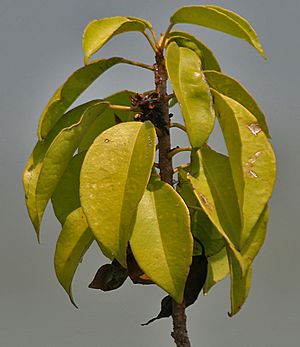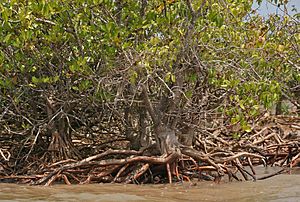Excoecaria agallocha facts for kids
Quick facts for kids Excoecaria agallocha |
|
|---|---|
 |
|
| Excoecaria agallocha in Krishna Wildlife Sanctuary, Andhra Pradesh, India | |
| Scientific classification | |
| Genus: |
Excoecaria
|
| Species: |
agallocha
|
Excoecaria agallocha, often called the blind-your-eye mangrove, is a special kind of plant found in mangrove forests. It's part of the Excoecaria group in the Euphorbiaceae plant family. People also call it the blinding tree or milky mangrove. These names hint at its secret: its sap, called latex, can be very irritating if it gets into your eyes.
This plant loves salty or slightly salty water. You can find it in warm, tropical mangrove forests. It grows in places like India, Bangladesh, and Australia. In Australia, it stretches from New South Wales all the way around to Western Australia.
Contents
What is the Blind-Your-Eye Mangrove?
Mangrove swamps are like special coastal wetlands in warm parts of the world. They are home to many unique plants and animals. The blind-your-eye mangrove usually grows a bit further away from the ocean. Here, the water is not quite as salty. For example, these mangroves grow around the old Thillai Chidambaram Temple in Tamil Nadu.
Plant Features
This small tree can grow up to 15 meters (about 50 feet) tall. Each tree is either male or female. Male flowers hang down like tassels. Female flowers grow on shorter spikes. Bees and other insects often visit the flowers to help them reproduce. The fruit is a small, dark, round capsule.
Why is it Called "Blind-Your-Eye"?
The blind-your-eye mangrove has strong chemical defenses. Its milky sap, or latex, is very poisonous and can cause a lot of irritation. This is common for plants in the Euphorbiaceae family. If the sap touches your skin, it can cause itching and blisters. If even a tiny bit gets into your eyes, it can cause temporary blindness. This is why it has such unusual names. Even its scientific name, Excoecaria, comes from a Latin word meaning "blinder."
Long ago, in 1777, Captain James Cook learned about this dangerous plant. Some of his sailors, who were cutting wood, became temporarily blind. Later, in 1789, William Bligh (famous for the mutiny on the Bounty) knew about this danger. He told his crew not to cut this tree when they were gathering wood in Tahiti. It was a good thing he did, because even the smoke from burning this wood can hurt your eyes. So, it wouldn't have been useful as firewood anyway.
Who Eats This Plant?
The sap of Excoecaria agallocha contains special plant poisons called phytotoxins. These chemicals are very irritating to skin, eyes, and other soft tissues.
Despite these strong defenses, one insect loves to eat this plant. The larvae (young) of the mangrove jewel bug (Calliphara nobilis) eat only the blind-your-eye mangrove. This jewel bug is found in tropical mangrove forests in parts of Asia.
How the Jewel Bug Uses Toxins
Like many other brightly colored insects, the mangrove jewel bug uses the plant's toxins for its own protection. It can take the chemical compounds from the plant and store them in its body. These chemicals are kept in special scent glands on the adult and young bugs. If these insects feel threatened, they can release an irritating and toxic fluid from these glands. This helps to scare away predators.
What is it Used For?
Even when the leaves are dried and crushed into a powder, they still contain the poison. This powder can quickly kill fish and has even been used on poison darts.
However, Excoecaria agallocha has also been found to have some medicinal uses. People have used it to help treat conditions like epilepsy, ulcers, leprosy, rheumatism, and paralysis. Because it has many complex chemicals, scientists think this plant might have even more new medicinal uses to discover.



